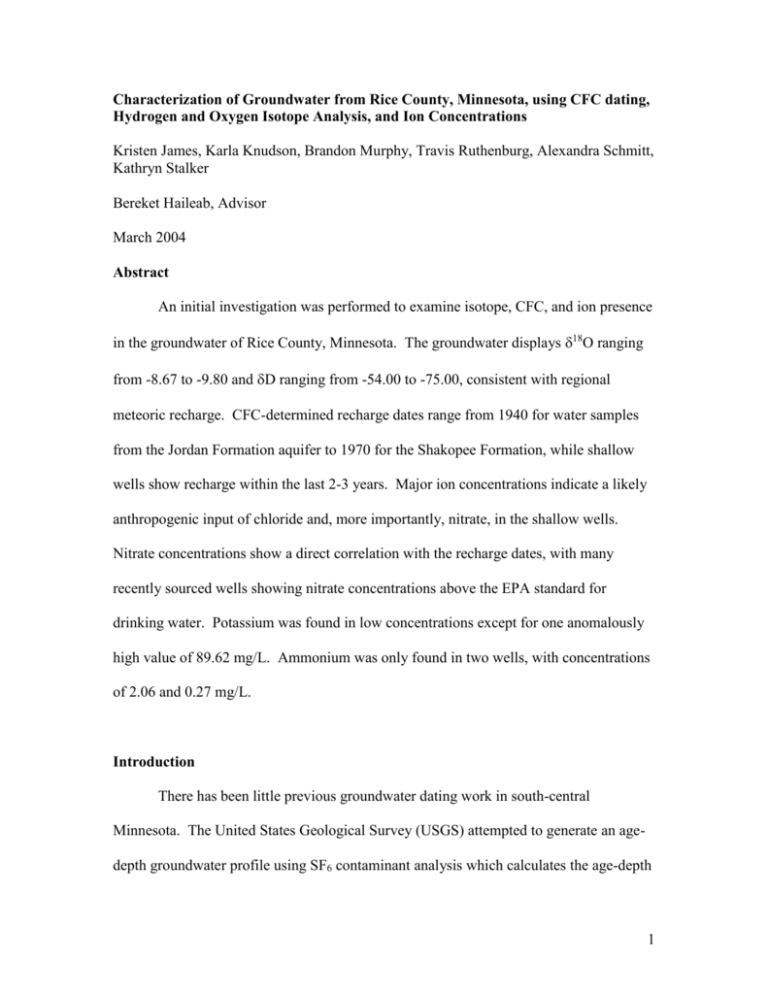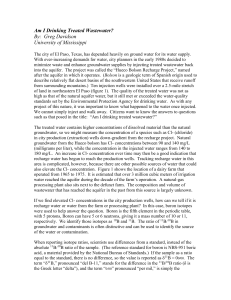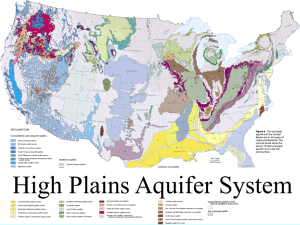Characterization of Groundwater from Rice
advertisement

Characterization of Groundwater from Rice County, Minnesota, using CFC dating, Hydrogen and Oxygen Isotope Analysis, and Ion Concentrations Kristen James, Karla Knudson, Brandon Murphy, Travis Ruthenburg, Alexandra Schmitt, Kathryn Stalker Bereket Haileab, Advisor March 2004 Abstract An initial investigation was performed to examine isotope, CFC, and ion presence in the groundwater of Rice County, Minnesota. The groundwater displays 18O ranging from -8.67 to -9.80 and D ranging from -54.00 to -75.00, consistent with regional meteoric recharge. CFC-determined recharge dates range from 1940 for water samples from the Jordan Formation aquifer to 1970 for the Shakopee Formation, while shallow wells show recharge within the last 2-3 years. Major ion concentrations indicate a likely anthropogenic input of chloride and, more importantly, nitrate, in the shallow wells. Nitrate concentrations show a direct correlation with the recharge dates, with many recently sourced wells showing nitrate concentrations above the EPA standard for drinking water. Potassium was found in low concentrations except for one anomalously high value of 89.62 mg/L. Ammonium was only found in two wells, with concentrations of 2.06 and 0.27 mg/L. Introduction There has been little previous groundwater dating work in south-central Minnesota. The United States Geological Survey (USGS) attempted to generate an agedepth groundwater profile using SF6 contaminant analysis which calculates the age-depth 1 profile through consideration of flow velocity and aquifer porosity (Ruhl et al., 2002). However, the USGS was not able to produce comparable data due to contamination of their samples. It can be noted, however, that the SF6 dating method has worked for tracing recharge younger than 30 years (Ruhl et al., 2002). The successful test on a well conducted by the USGS in northeastern Dakota County had an age-depth profile spanning to 19 years from a depth of 85 feet (Ruhl et al., 2002). Chlorofluorocarbons (CFCs) are halogenated alkanes that were first introduced in the 1930s and primarily used as refrigerants. Dichlorodifluoromethane, known as CFC12, was first produced industrially as early as 1931. Production of trichlorofluoromethane, or CFC-11, started in 1936. Many other CFCs have been developed since, including CFC-113 (Cook, 2000). CFC-11 and 12 have primarily been used as refrigerants, blowing agents in plastics, aerosol propellants, and solvents. CFC113 was primarily used by the electronics industry in semiconductor manufacturing (Cook, 2000). CFCs are incorporated into the hydrological cycle closely following their release into the atmosphere after production and accumulate there due to their extremely long lifespan (Busenberg, 1992). The recharge age of the water can be determined from the concentration of CFC in the water. This recharge age is defined as the time since the groundwater became isolated from the unsaturated zone (Busenberg, 1992). Because of their relatively recent emission into the atmosphere, CFC dating is useful for calculating recharge dates within approximately the past 50 years (Cook, 2000). The Prairie du Chien-Jordan aquifer is the primary water supply for Rice County. It is confined between glacial drift and bedrock units, and 27% of precipitation infiltrates as recharge (0.27 recharge rate). However, recharge data is hard to confidently determine 2 for confined aquifers because of the cones of depression made from withdrawal. Mean annual precipitation in northern Rice County is 30 inches per year, with annual recharge for groundwater roughly 8.1 inches, with a minimum estimate of 3.6 inches and maximum estimate of 13.2 inches (Ruhl et al., 2002). Studies of Minnesota aquifers in the Minneapolis-St. Paul metropolitan region have been done by the USGS, covering the counties of Anoka, Carver, Dakota, Hennepin, Ramsey, Scott, and Washington. Comparative data from bordering Dakota County may give insight about the Prairie du Chien-Jordan aquifer recharge rates in our study of Rice County. Over the past four years, undergraduate students from Carleton College have compiled extensive surface water chemistry data for Rice County, Minnesota. However, there is limited information available on groundwater chemistry. To address this, samples were collected from a total of 19 private wells and springs and analyzed for their ion content, stable isotope ratios, and CFC concentrations. The major anions measured were fluoride, chloride, nitrite, nitrate, phosphate, and sulfate. The major cations for which the waters were tested were sodium, potassium, magnesium, calcium, lithium, and ammonium. By discerning the dissolved gas concentration of the chlorofluorocarbons (CFC-11, 12, and 113), the age of the water in the wells and springs can be determined. Methods Within a week in late January and early February 2004, water samples were collected from 26 wells and 2 springs around Rice and Dakota counties in Minnesota (Figure 1). Five samples from each location were gathered in 4 oz. SKS glass bottles 3 with foil-lined caps and were sealed by either tape or parafilm. Bottles were filled while submerged to prevent air contamination. Collection of the water was done following methods described by the Reston CFC Lab ((RCL), 2003) At Carleton College a Dionex Ion Chromatograph (IC) was used to perform anion and cation analysis. The water samples were tested for Na+, K+, Mg+, Ca2+, Li+, NH3+, Fl-, Cl-, Br-, NO2, NO3-, PO43-, and SO42-. Using an auto-injector, 5 mL vial was filled for each sample loaded into the IC. At the University of Utah, water samples from twenty locations were examined using a purge-and-trap gas chromatograph system with an electron capture detector (GCECD). The water was analyzed for three types of CFCs: CFC-11, CFC-12, and CFC-113. Hydrogen and oxygen mass spectrometry were also performed on different sample subsets at the University of Utah. Preparation of samples for determination of δD ratios began by transferring 50µL of sample to a microcapillary tube. The microcapillary tube was transferred to a previously evacuated, nitrogen-filled glass tube containing Hayes metal. The glass tube was submerged in liquid nitrogen for 60 seconds to freeze the sample. The glass tube was then evacuated and heat-sealed under a vacuum. Sample tubes were heated in a 500°C furnace for 60 minutes. All samples were run using a dualinlet Finnigan Delta Plus mass spectrometer comparing a sample in one inlet to a standard gas in the other inlet. Results were normalized to measured standards. For oxygen isotope analysis, 0.5 mL of water was equilibrated with 6% CO2 in N2 gas in an incubating shaker at 22ºC for five days. Fifty headspace gas injections were put into a two meter long PLOT (porous-layer open tubular column) at 50ºC under 5 PSI of helium (to control flow speed). Injections were done every 200 seconds, and elution time 4 for each injection was approximately 300 seconds. These settings proved sufficient for N2 and CO2 peak separation before inlet to the Finnigan MAT 252 isotope ratio mass spectrometer. ∂18O sample values were corrected to three internal standards prepared and analyzed with water samples: UU DI (∂18O=-16.5‰VSMOW), EVIAN (∂18O=-10.5‰ VSMOW), and UU ZERO (∂18O=-0.2‰ VSMOW). Unknown samples were corrected to account for linear increase in the difference between the measured and known values of the standards at decreasing ∂18O values. Multiple injections of each preparation and multiple preparations of each standard yielded a standard deviation of only 0.4‰, and multiple injections of unknown sample yielded only a 0.2‰ standard deviation, after outliers were discounted. Multiple preparations of unknowns did yield slightly higher standard deviations. Minimal machine drift occurred during three 5000-second runs, so no correction was applied. Results Anions Of the seven anions for which the samples were tested, two anions, bromide and phosphate were not found. Sulfate and chloride were always present, often in large amounts, with concentrations ranging from 0.11 to 62.93 mg/L and 0.08 to 72.54 mg/L, respectively (Table 1). Fluoride was always present as well, but in smaller concentrations, which ranged from 0.14 to 0.32 mg/L (Table 1). Nitrate-N was found in 14 of the 19 samples, with concentrations ranging from 0-13.52 mg/L (Table 1). NitriteN was detected in only three of the test sites, with concentration levels ranging from 0.14 to 0.83 mg/L (Table 1). 5 Cations Ammonium was only found in two wells, the values were 2.06 and 0.27 mg/L (Table 2). Lithium levels were extremely low, with a maximum concentration of 0.65 mg/L. Sodium levels ranged from 5.42-45.31 mg/L, with most samples falling under 25 mg/L (Table 2). Potassium levels were relatively low across the board, ranging from 0.97-7.50 mg/L with one well showing a potassium value of 89.62 mg/L (Table 2). Magnesium concentrations varied from 28.94-63.14 mg/L (Table 2). Calcium levels were a bit higher overall, ranging from 39.08-109.03 mg/L (Table 2). CFCs CFC-determined recharge dates are presented in Table 3. The CFC-11determined groundwater recharge dates fluctuated from 1966 in some of the deeper wells (those which come from the Jordan Formation aquifer) to 2004 in wells of unknown depth. The CFC-12-determined dates were similar, ranging from 1961 in the Jordan to 2004 in unknown depths. However, the CFC-113-determined dates were much older from several sources, showing values between 1940 and 1989. Stable Isotopes The groundwater displays 18O ranging from –8.67 to –9.80 and D ranging from –54.00 to –75.00 (Table 4). However, the analyses that produced these data were not performed for all sample sites. Discussion Anions 6 The Rice County chloride data from ion chromatograph tests range from 0.0872.54 mg/L. While this range is large, all data points fall within reasonable and safe boundaries. Chloride does not have any health warnings regarding its content in drinking water; however, a 250 mg/L maximum contaminant level has been set so that excess chloride does not adversely affect the taste of the water. The primary source of chloride is halite in rocks, while the anthropogenic source is mainly road salt. Chloride is also a component in fertilizers, human and animal waste, and industrial applications (MPCA, 1999a). Fluoride is not associated with any health warning, but a maximum contamination level of 4 mg/L is listed to prevent teeth staining (MPCA, 1999a). Our fluoride data ranges from 0.12-0.22 mg/L, which is well below the maximum recommended levels. The main source of fluoride in groundwater is weathering from igneous rocks, though it is also often found in limestone and dolomites in the form of fluorite. Our findings are consistent with tests performed by the MN PCA, which show that no aquifers in the state appear to have elevated concentrations, and localized instances are a function of mineral weathering rather than any anthropogenic sources (MPCA, 1999a). The IC test for sulfate in Rice County yielded a range of 8.72-62.93 mg/L. Sulfate, like fluoride, does not have a health-based standard, but high levels can cause unpleasant tastes and laxative-producing effects (MN PCA, 1999b). Therefore, a maximum contaminant levels has been set at 500 mg/L, which is an order of magnitude greater than the levels found in the tested waters (MN PCA, 1999b). Sulfate comes from gypsum and pyrite contained in the aquifers and is deposited in the ground through 7 precipitation of oxidized sulfur from fossil fuel combustion. Other anthropogenic sources are fertilizers and animal waste (MPCA, 1999b). Nitrate values range from 0 to 13.52 mg/L with a mean level of 5.07 mg/L. The general trend of our nitrate data is that nitrate is not present or present in levels around 614 mg/L. Four wells in our study had nitrate-N levels above the limit of 10 mg/L for drinking water established by the Minnesota Department of Health (MPCA, 1998). The major health risk of excess nitrates, “blue baby syndrome,” or methemoglobinemia, occurs when bacteria in the stomach converts nitrate into nitrite, which reduces the blood’s capacity to carry oxygen to vital organs (MPCA, 1998). Children and adults older than six months of age usually have enough stomach acid to inhibit methemoglobinemia-causing bacteria (MPCA, 1998). Previous testing by other groups has not found the high nitrate levels shown here (GWMAP, 1999). One study cites the Jordan aquifer has a mean nitrate level of 5.9 mg/L and with only one well location in all of southeastern Minnesota to exceed 10 mg/L nitrates (GWMAP, 1999). Further investigation of nitrate levels is warranted, especially correlating presence of nitrate with well depth. The highest nitrate levels of Minnesota are found in the Jordan aquifer (GWMAP, 1999). Little nitrate is found in aquifers below 70 feet, as the excess material acts as a filter to remove contaminants (GWMAP, 1999). Unfortunately, northeastern Rice County’s aquifer is near the surface and therefore more readily exposed to nitrates. The majority of the samples we obtained are located in what is assessed as a “very high” risk aquifer zone, where it can take between hours and months of estimated vertical travel time before water-borne surface contamination could reach the aquifer (Campion, 1997). 8 The main source of nitrates in water is anthropogenic, mostly from fertilizers, but also from improperly working septic systems (MPCA, 1998). Bromide and phosphate were not found in any of our samples. Nitrite was only found in three wells. Because the amounts were so small, we attributed this to a microprobe origin and did not investigate further. Cations Lithium values were small (maximum 0.65 mg/L) and often not present, therefore warranting no further investigation. Ammonium is only found in two of our wells in very small concentrations (2.06 and 0.27 mg/L). Concern about ammonium levels arise when the values correlate with nitrates because this indicates the presence of fertilizers. Neither of our wells with ammonium had nitrates, so the source of ammonium is unknown, but not related to fertilizer contamination. The sodium values obtained ranged from 5.42 mg/L to 45.31 mg/L. The sodium values generally correlated with chloride, therefore indicating an anthropogenic input of both, most likely through road salting. Sodium is also commonly found in minerals and soil. There is little heath risk for relatively high sodium levels in water (MPCA, 1999c). Potassium values of the Rice County well water were generally between 1 and 8 mg/L, with an outlier value of 89.62 mg/L. Potassium is a major component of soil and rocks, as well as applied as fertilizer (MPCA, 1999c). The one outlier potassium value occurs at the same well as our highest nitrate value, therefore indicating fertilizer 9 contamination. However, no health risks are associated with potassium in drinking waters (MPCA, 1999c). Calcium and magnesium values range from 28.94-63.14 mg/L and 39.08-109.03 mg/L respectively. Both cations are abundant in minerals and soils, particularly in dolomites, which make up part of the aquifer. Anthropogenic sources tend to be negligible compared to natural sources (MPCA, 1999d). CFCs The detection limit for CFCs is around 0.3 pg/kg of water using GC-ECD. Using estimated CFC atmospheric concentrations, Henry’s Law solubilities, and taking into account the detection limits, CFC-12, CFC-11, and CFC-113 can be used to date water recharged since 1941, 1947, and 1955 respectively (Figure 2) (Cook, 2000). For five of our sources, the CFC-determined dates matched closely within error. These results are most reliable and give us the best estimation of water recharge rate. However, these recharge dates could be inaccurate for several reasons. One consistent source of error is excess air in the sample bottle; however, since all of the samples contained no large air bubbles, the error is probably no more than 2 years (Solomon, 2004). Another source of error is the estimated recharge temperature used to calculate the CFC solubilities. If the actual recharge dates are between 1970 and 1990, and the error in temperature is 2°C off, the dates could be off between one and three years. Incorrect recharge elevation, another possible source of error, would lead to an incorrect barometric pressure, which would also lead to incorrectly calculated solubilities (Cook, 10 2000). However, the difference in the solubilities is usually small enough that this error is negligible. For five other wells, the CFC-113-determined age was significantly older than the ages calculated for CFC-11 and CFC-12. The dates calculated for CFC-11 and CFC-12 for all of these wells were in the 1960’s and 1970’s. The CFC-113 was below the detection limit, which means pre-1955. This discrepancy could not be explained by the errors listed previously since excess air, wrong recharge temperature, etc. would affect all three calculated recharge dates similarly. One possibility is differences in sorption potential for each of the three CFCs. It is well documented that sorption for CFC-11 and CFC-12 is negligible; however, the sorption potential for CFC-113 has not been studied thoroughly, so it is not known whether this could affect our dating. Another source of error where the calculated dates do not agree is microbial degradation, which occurs in anoxic environments. However, degradation is unlikely in this case since CFC-113 tends to degrade less readily than CFC-11, so the oldest calculated dates should be from CFC11 if degradation occurred (Cook, 2000). Thus, for these wells, the actual recharge date is difficult to estimate. There were four other wells where the oldest calculated recharge date was from CFC-113; however there was a detectable level of CFC-113. The recharge dates were much younger. Once again, sorption is a possible source of error. Another possibility is that there is contamination from VOCs, which would lead to a higher concentration of certain CFCs and thus a younger date (Busenberg, 1992). Again, actual recharge date is hard to estimate. Tritium dating would be necessary to more precisely determine the date of recharge. 11 In the water from the Cannon River Wilderness Park spring, the calculated recharge dates were relatively close. For the remaining wells, the oldest calculated dates were from CFC-11, the next oldest from CFC-113, and the youngest dates from CFC-12. This is consistent with the patterns of microbial degradation. In cases where CFC-11 has been severely degraded, the recharge date found for CFC-12 tends to be consistent with the 3H-determined date (Cook, 1995). Hence, the CFC-12 recharge dates are probably the most accurate. Stable Isotopes The groundwater displays 18O ranging from –8.67 to –9.80 and D ranging from –54.00 to –75.00, consistent with regional meteoric recharge. According to data compiled by (Friedman, 1964), δ18O and δD values fall within the range for meteoric waters in this region of the country. These values agree with the relatively young apparent ages of the water and suggest a regional or local recharge area. Conclusions Oxygen and Hydrogen isotopic signatures and CFC content indicate that the surveyed Rice County wells are recharged from young meteoric sources. Wells recharged within the last 25 years show high nitrate levels, likely from anthropogenic sources. Future studies could be aided by a number of procedural modifications. The accuracy and precision of CFC dating can be improved by recording the water 12 temperature during sample collection. Corroboration with the Tritium signature and SF6 content could prove useful for confirming the accuracy of CFC dating. Acknowledgments Funding for this project was provided by Carleton College Geology Department. We would like to thank Dr. Thure Cerling, Dr. D. Kip Solomon and Craig Cook for demonstrating and explaining the design of their instruments and methodology of CFC, Oxygen and Hydrogen Isotopes. The assistance of Dr. Francis Brown, Scott Hynek, Benjamin Passey, Melissa Klinder, Alan Rigby, is gratefully acknowledged. We are indebted to the following persons who have assisted in securing samples. Victor Suma, Claire Ericksen, David and Stephanie Henriksen, Jen Macalady and David Bice, Dobrahner, Cindy and Ed Buchwald, Gene Bakko, Jean and Lyale Myers, Jim Braucher, John and Vicky Tripp, John Dudley, John Maakestad, Lien, Mary Ellen Frame , and Robert Flatten. References Busenberg, E. P., L. Niel, 1992, Use of Chlorofluorocarbons (CCl3F and CCl2F2) as Hydrologic Tracers and Age-Dating Tools: The Alluvium and Terrace System of Central Oklahoma: Water Resources Research, v. 28, no. 9, p. 2257-2283. Campion, M., 1997, Sensitivity to Pollution of the St. Peter- Praire Du Chien- Jordan and St. Lawrence- Franconia Aquifers." Geology Atlas of Rice County, Minnesota: St. Paul, Minnesota, Minnesota Department of Natural Resources. Cook, P. G. H., Andrew L., 2000, Environmental Tracers in Subsurface Hydrology: Boston, Klewer Academic Pubilishers. Cook, P. G. S., D.K.; Plummer, L.N.; Busenberg, E.; Schiff, S.L., 1995, Chlorofuorocarbons as tracers of groundwater transport processes in a shallow, silty sand aquifer: Water Resources Research, v. 31, no. 3, p. 425-434. 13 Friedman, I., Redfield, A. C., Schoen, B., Harris, J., 1964, The Variation of the Deuterium Content of Natural Waters in the Hydrologic Cycle: Reviews of Geophysics, v. 2, no. 1, p. 177-224. GWMAP, G. W. M. a. A. P.-. 1999, Baseline Water Quality of Minnesota's Principal Aquifers: Twin Cities Metropolitan Region: Minnesota Pollution Control Agency. MPCA, 1999a, Chloride and Flouride in Minnesota's Ground Water: Minnesota Pollution Control Agency. MPCA, 1999b, Sulfate in Minnesota's Ground Water: Minnesota Pollution Control Agency. MPCA, 1999c, Sodium and Potassium in Minnesota's Ground Water: Minnesota Pollution Control Agency. MPCA, 1999d, Barium, Beryllium, Calcium, Magnesium and Strontium in Minnesota's Ground Water: Minnesota Pollution Control Agency. MPCA, M. P. C. A., 1998, Baseline Water Quality of Minnesota's Principal Aquifers, Minnesota Pollution Control Agency. (Reston Chlorofluorocarbon Laboratory), R. C. L., 2003, Collection and preservation of water samples for chlorofluorocarbon analysis in glass bottles with foil-lined caps: Reston, VA, p. 8. Ruhl, J. F., Kanivetsky, R., Shmagin, B. A., Anoka County (Minn.), Carver County (Minn.), Dakota County (Minn.), Minnesota Board of Water & Soil Resources., and Geological Survey (U.S.), 2002, Estimates of recharge to unconfined aquifers and leakage to confined aquifers in the seven-county metropolitan area of Minneapolis-St. Paul, Minnesota, Water-resources investigations report ; 024092.: Mounds View, MN Denver, CO, U.S. Dept. of the Interior U.S. Geological Survey ; Branch of Information Services [distributor], iv, 32 p. Solomon, D. K., 2004, Error of CFC Dating, in Geochemistry Class, C. C., ed.: Northfield, MN. 14





